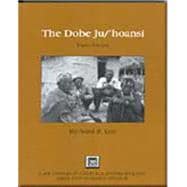
Note: Supplemental materials are not guaranteed with Rental or Used book purchases.
Purchase Benefits
What is included with this book?
| Foreword | iii | ||||
| Preface to the Third Edition | vii | ||||
| Preface to the Second Edition | viii | ||||
| Preface to the First Edition | xi | ||||
| A Note on the Ju Language | xii | ||||
| Acknowledgments | xv | ||||
|
1 | (8) | |||
|
1 | (2) | |||
|
3 | (6) | |||
|
9 | (14) | |||
|
11 | (1) | |||
|
11 | (3) | |||
|
14 | (1) | |||
|
14 | (4) | |||
|
18 | (5) | |||
|
23 | (14) | |||
|
24 | (2) | |||
|
26 | (1) | |||
|
26 | (2) | |||
|
28 | (4) | |||
|
29 | (3) | |||
|
32 | (4) | |||
|
32 | (1) | |||
|
33 | (2) | |||
|
35 | (1) | |||
|
36 | (1) | |||
|
37 | (22) | |||
|
40 | (8) | |||
|
40 | (3) | |||
|
43 | (3) | |||
|
46 | (2) | |||
|
48 | (3) | |||
|
48 | (1) | |||
|
49 | (2) | |||
|
51 | (2) | |||
|
53 | (5) | |||
|
56 | (2) | |||
|
58 | (1) | |||
|
59 | (18) | |||
|
60 | (4) | |||
|
64 | (10) | |||
|
64 | (5) | |||
|
69 | (3) | |||
|
72 | (2) | |||
|
74 | (3) | |||
|
77 | (14) | |||
|
77 | (3) | |||
|
80 | (2) | |||
|
82 | (3) | |||
|
85 | (1) | |||
|
86 | (1) | |||
|
87 | (2) | |||
|
89 | (2) | |||
|
91 | (18) | |||
|
91 | (3) | |||
|
94 | (2) | |||
|
96 | (2) | |||
|
98 | (1) | |||
|
99 | (4) | |||
|
99 | (2) | |||
|
101 | (2) | |||
|
103 | (1) | |||
|
104 | (3) | |||
|
107 | (1) | |||
|
107 | (2) | |||
|
109 | (16) | |||
|
109 | (2) | |||
|
109 | (2) | |||
|
111 | (1) | |||
|
112 | (3) | |||
|
115 | (3) | |||
|
118 | (1) | |||
|
118 | (7) | |||
|
125 | (16) | |||
|
126 | (4) | |||
|
128 | (1) | |||
|
129 | (1) | |||
|
130 | (5) | |||
|
133 | (2) | |||
|
135 | (2) | |||
|
137 | (4) | |||
|
141 | (10) | |||
|
141 | (2) | |||
|
143 | (2) | |||
|
145 | (2) | |||
|
147 | (1) | |||
|
148 | (3) | |||
|
151 | (16) | |||
|
153 | (4) | |||
|
157 | (2) | |||
|
159 | (1) | |||
|
159 | (3) | |||
|
162 | (1) | |||
|
162 | (5) | |||
|
167 | (26) | |||
|
168 | (1) | |||
|
169 | (5) | |||
|
174 | (2) | |||
|
176 | (1) | |||
|
176 | (1) | |||
|
177 | (1) | |||
|
178 | (3) | |||
|
181 | (8) | |||
|
186 | (3) | |||
|
189 | (1) | |||
|
190 | (3) | |||
|
193 | (8) | |||
|
197 | (4) | |||
| Postscript: The /Gwihaba Dancers | 201 | (6) | |||
| Appendix A: Eating Christmas in the Kalahari | 207 | (6) | |||
| Appendix B: The Kalahari Debate: Ju/'hoan Images of the Colonial Encounter | 213 | (16) | |||
| Glossary of Ju/'hoan and Other Non-English Terms | 229 | (2) | |||
| Films of the Ju/'hoansi: An Annotated List | 231 | (4) | |||
| References Cited and Recommended Readings | 235 | (8) | |||
| Index | 243 |
The New copy of this book will include any supplemental materials advertised. Please check the title of the book to determine if it should include any access cards, study guides, lab manuals, CDs, etc.
The Used, Rental and eBook copies of this book are not guaranteed to include any supplemental materials. Typically, only the book itself is included. This is true even if the title states it includes any access cards, study guides, lab manuals, CDs, etc.